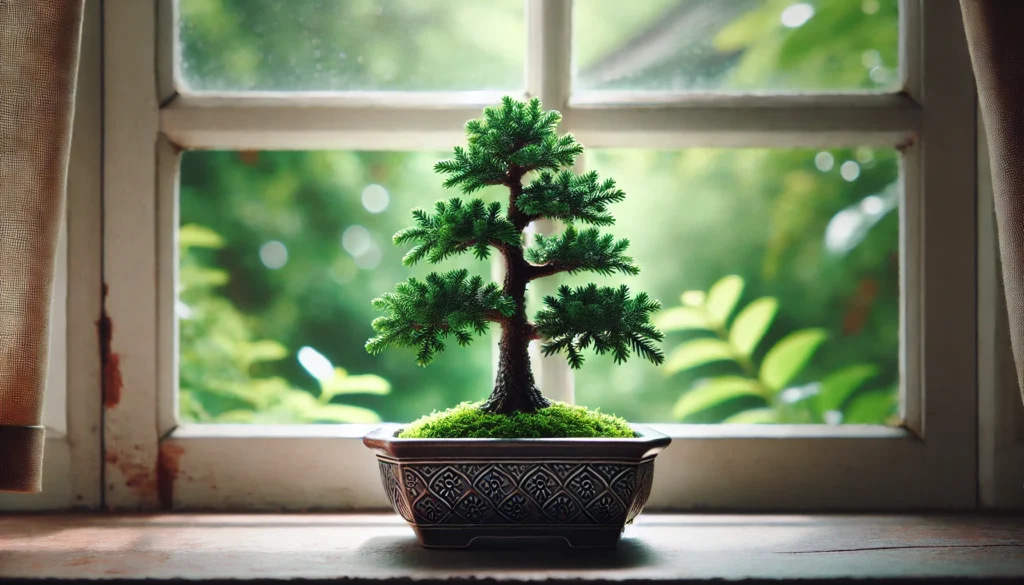
How to Grow and Care for a Bonsai Sequoia: A Complete Guide for Beginners
Imagine having a tiny, miniature version of one of the tallest trees in the world right in your home. 
In this complete guide, we’ll walk you through everything you need to know to grow and maintain a healthy bonsai sequoia. Whether you’re a beginner or have some experience with bonsai, you’ll find practical, step-by-step advice to help your bonsai sequoia thrive. From choosing the right soil to understanding the perfect watering schedule, we’ve got you covered. Let’s dive in and unlock the secrets to creating your own mini Sequoia masterpiece!
Table of Contents
ToggleUnderstanding the Bonsai Sequoia 
The Bonsai Sequoia is a unique and stunning miniature tree that mimics the grandeur of its full-sized counterpart, the towering Sequoia tree. Known for its impressive height and distinctive red-brown bark in nature, the Bonsai Sequoia brings a piece of the great outdoors right into your home or garden. If you’re new to growing bonsai or considering a Sequoia for your collection, it’s essential to understand its unique characteristics and care needs. Let’s dive in!
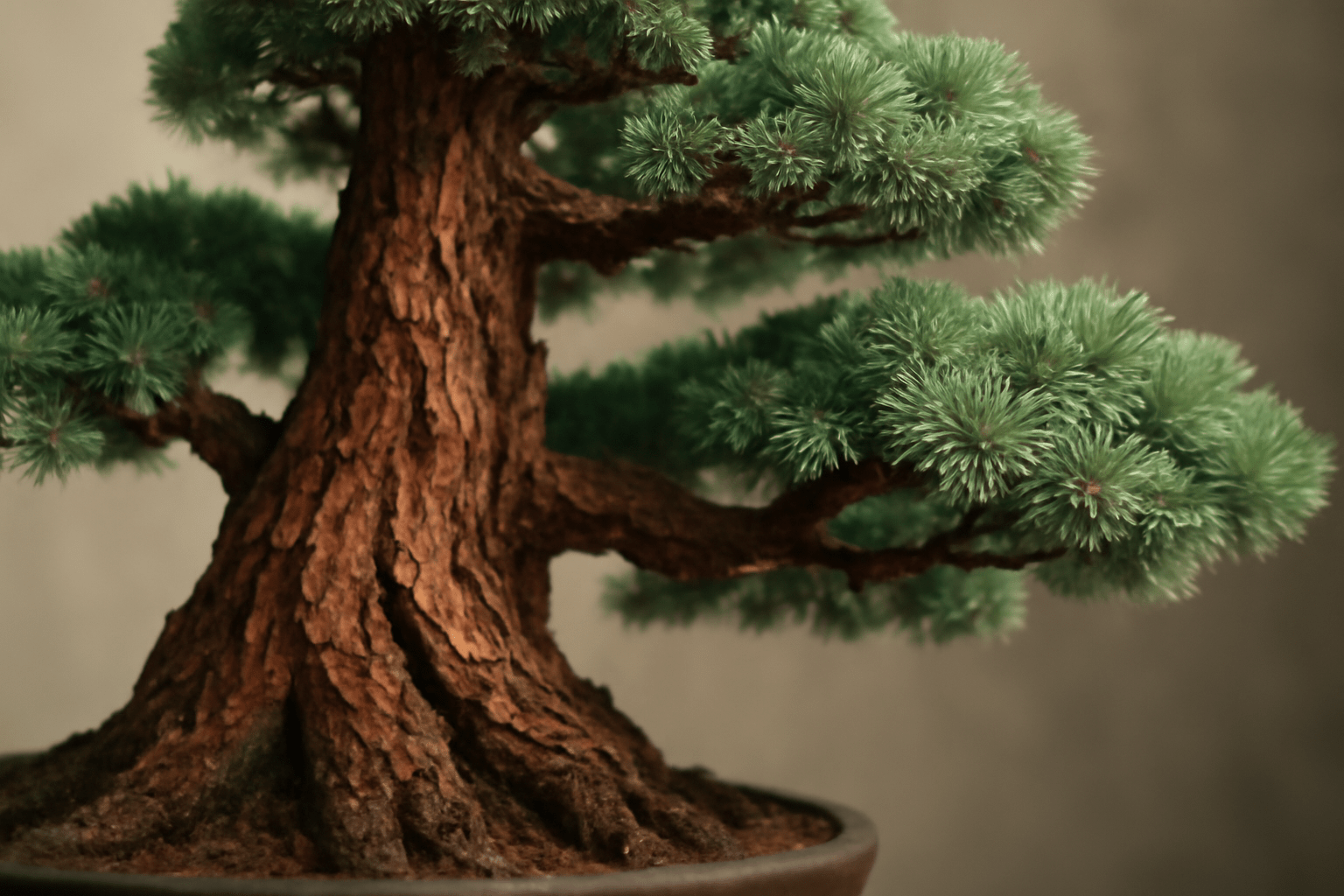
The Sequoia Bonsai: A Miniature Giant
The Sequoia Bonsai is a representation of the famous Sequoia tree, which can grow over 300 feet tall in the wild. However, in bonsai form, it’s a much smaller, more manageable tree that can thrive in indoor or outdoor settings with proper care. These trees have needle-like leaves and a rugged, textured bark that gives them a very ancient, majestic look.
The Bonsai Sequoia’s delicate size does not detract from its strength and resilience. With a little effort and the right conditions, this miniature tree can be just as awe-inspiring as its larger relatives.
Key Features of a Bonsai Sequoia 
- Height: While the full-sized Sequoia can reach towering heights, your bonsai will only grow to about 12-18 inches tall, making it ideal for small spaces.
- Foliage: Its soft, needle-like foliage is typically dark green, adding a lush, dense look to your bonsai. In the right environment, these trees can also develop reddish bark, similar to the mature Sequoia.
- Lifespan: With the right care, a Bonsai Sequoia can live for decades, so it’s a long-term addition to your plant collection.
Why Grow a Bonsai Sequoia? 
- Low Maintenance: Unlike other bonsai species, the Sequoia is relatively easy to care for, making it a great choice for beginners.
- Aesthetic Appeal: With its unique bark and elegant foliage, the Bonsai Sequoia adds a touch of nature’s majesty to any room or garden.
- Calming Presence: Many people find bonsai trees therapeutic and calming. The Bonsai Sequoia, in particular, offers a sense of tranquility, connecting you to the natural world.
Where to Keep Your Bonsai Sequoia 
- Indoors: Place it in a bright spot with indirect sunlight. A windowsill facing east or west is perfect. Avoid direct sunlight, which can scorch its delicate needles.
- Outdoors: The Bonsai Sequoia can thrive outdoors in moderate climates, but be mindful of temperature extremes. During winter, it may need to be brought inside if the weather becomes too cold.
Bonsai Sequoia Care Tips 
- Watering: Keep the soil consistently moist, but not soggy. Water when the top inch of soil feels dry to the touch. Ensure good drainage to avoid root rot.
- Humidity: Bonsai Sequoias appreciate a humid environment, so if you’re growing it indoors, consider placing a humidity tray under the pot or using a room humidifier.
- Pruning: Regular pruning is essential to maintain its shape and size. Trim the foliage to encourage growth and remove any dead or damaged branches.
- Feeding: Feed your Bonsai Sequoia with a balanced fertilizer during the growing season (spring and summer). Reduce feeding in the fall and winter.
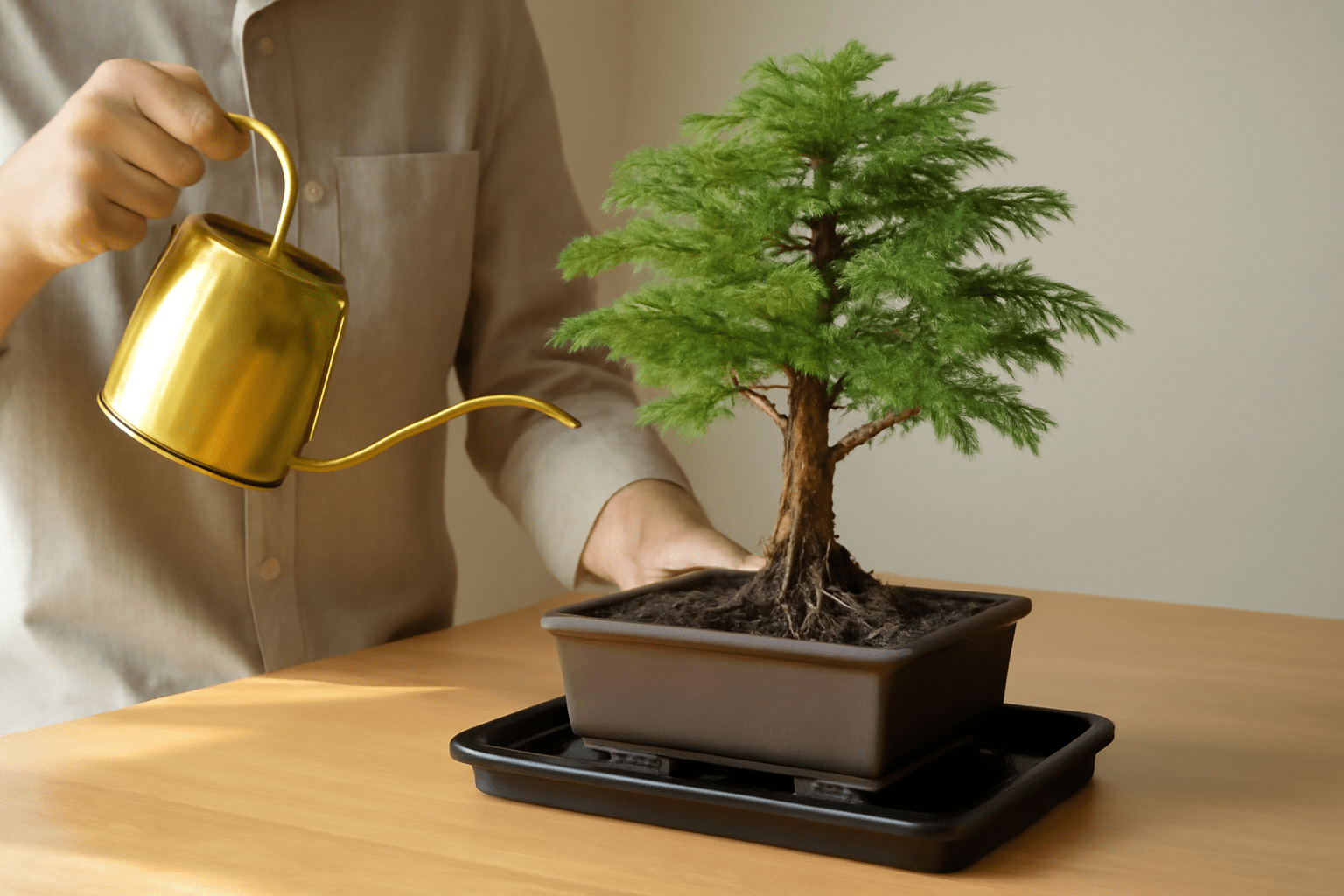
Common Challenges & Solutions 
- Yellowing Needles: This could be due to overwatering or poor drainage. Ensure that your bonsai pot has sufficient drainage holes and water it only when the soil is dry.
- Pest Problems: Like many bonsai species, the Sequoia can attract pests like aphids or spider mites. Regularly check the leaves and treat with natural pest control if necessary.
By understanding the unique needs of the Bonsai Sequoia, you can provide it with the ideal care and enjoy its beauty for many years to come. Whether you’re a beginner or an experienced bonsai enthusiast, this miniature giant will add a touch of natural elegance to your home or garden.
Setting Up Your Bonsai Sequoia 
Starting your Bonsai Sequoia journey begins with the right setup. With a few simple steps, you can create the perfect environment for your miniature giant to thrive. Here’s how to set up your Bonsai Sequoia for success!
1. Choose the Right Pot 
Selecting the right pot is crucial for your Bonsai Sequoia’s health. Go for a shallow, wide container with drainage holes. This ensures proper water flow and prevents root rot. Bonsai Sequoias have delicate root systems that need plenty of room to spread out, but they don’t like to be “too comfy”—so avoid large pots that might hold too much water.
2. Prepare Well-Draining Soil 
Soil is a key factor in your Bonsai Sequoia’s success. Use a well-draining bonsai soil mix that allows water to flow freely but retains enough moisture for the roots. A mix of akadama, pumice, and lava rock works wonders for Sequoias, helping maintain a balance of moisture and airflow. Your tree will love it!
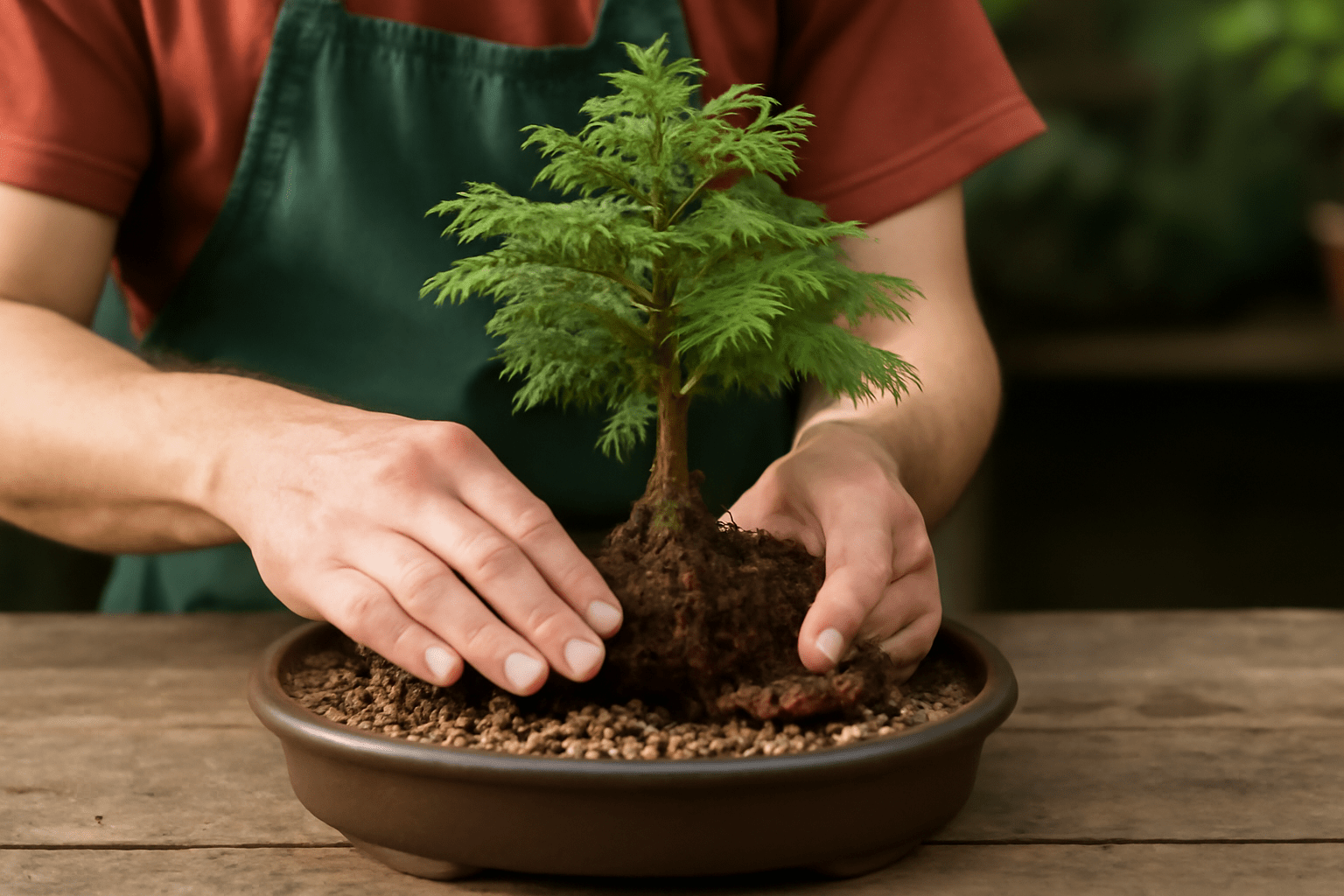
3. Position Your Bonsai Sequoia 
Bonsai Sequoias are outdoor trees, so place them in a spot where they can receive plenty of sunlight (about 4-6 hours a day). If you’re growing indoors, make sure to provide them with supplemental lighting to mimic natural sunlight. A south-facing window is ideal, or you can use grow lights for the best results.
4. Watering Wisely 
Bonsai Sequoias need consistent moisture, but they don’t like to sit in water. Water your Sequoia when the top inch of soil feels dry, ensuring the water drains through the bottom. Never let the roots sit in water, as this can cause rot. In dry conditions, misting your tree can help boost humidity, which is something Sequoias love!
5. Temperature & Humidity Control 
Your Bonsai Sequoia prefers moderate temperatures, between 50°F and 75°F (10°C – 24°C). Keep it in a place with good airflow, away from drafts or heat sources like radiators. To boost humidity, especially in dry climates or during winter, consider using a humidity tray or placing a small humidifier nearby.
6. Pruning and Shaping 
Once your Sequoia is settled, you can begin pruning. Regular trimming helps to shape the tree and promote healthy growth. Cut back on new growth during the growing season (spring and summer), but avoid heavy pruning in winter when the tree is in a dormant state. Always use clean, sharp tools to make neat cuts that help your tree heal faster.
7. Fertilizing for Growth 
To support your Sequoia’s growth, feed it with a balanced bonsai fertilizer every 4-6 weeks during the growing season. Opt for organic, slow-release fertilizers that provide nutrients over time. Over-fertilizing can harm your tree, so always follow the instructions on the label.
By following these simple steps, you’ll set your Bonsai Sequoia up for a long, healthy life! Take your time, and enjoy the process of watching this majestic tree grow into a beautiful miniature version of its towering cousin.
Planting Your Bonsai Sequoia 
Planting your Bonsai Sequoia is an exciting step in the bonsai journey! Whether you’re a beginner or have some experience, this process will set the foundation for a healthy and thriving tree. Follow these simple steps to ensure your Bonsai Sequoia gets the best start.
1. Choose the Right Pot 
Start with a shallow, well-draining pot. Bonsai trees need good drainage to prevent waterlogged roots, which can lead to root rot. A pot with drainage holes is a must! For your Sequoia, pick a pot that is slightly larger than the root system. As your tree grows, you can gradually move it into a bigger pot if needed.
2. Use Quality Soil 
Bonsai Sequoias require soil that drains well but still retains enough moisture to keep the roots hydrated. A mix of akadama (a granular clay) and pumice is ideal. You can also use a pre-made bonsai soil mix. Avoid regular garden soil, as it’s too dense and can cause poor drainage. Make sure to add a layer of small rocks or gravel at the bottom of the pot to improve drainage.
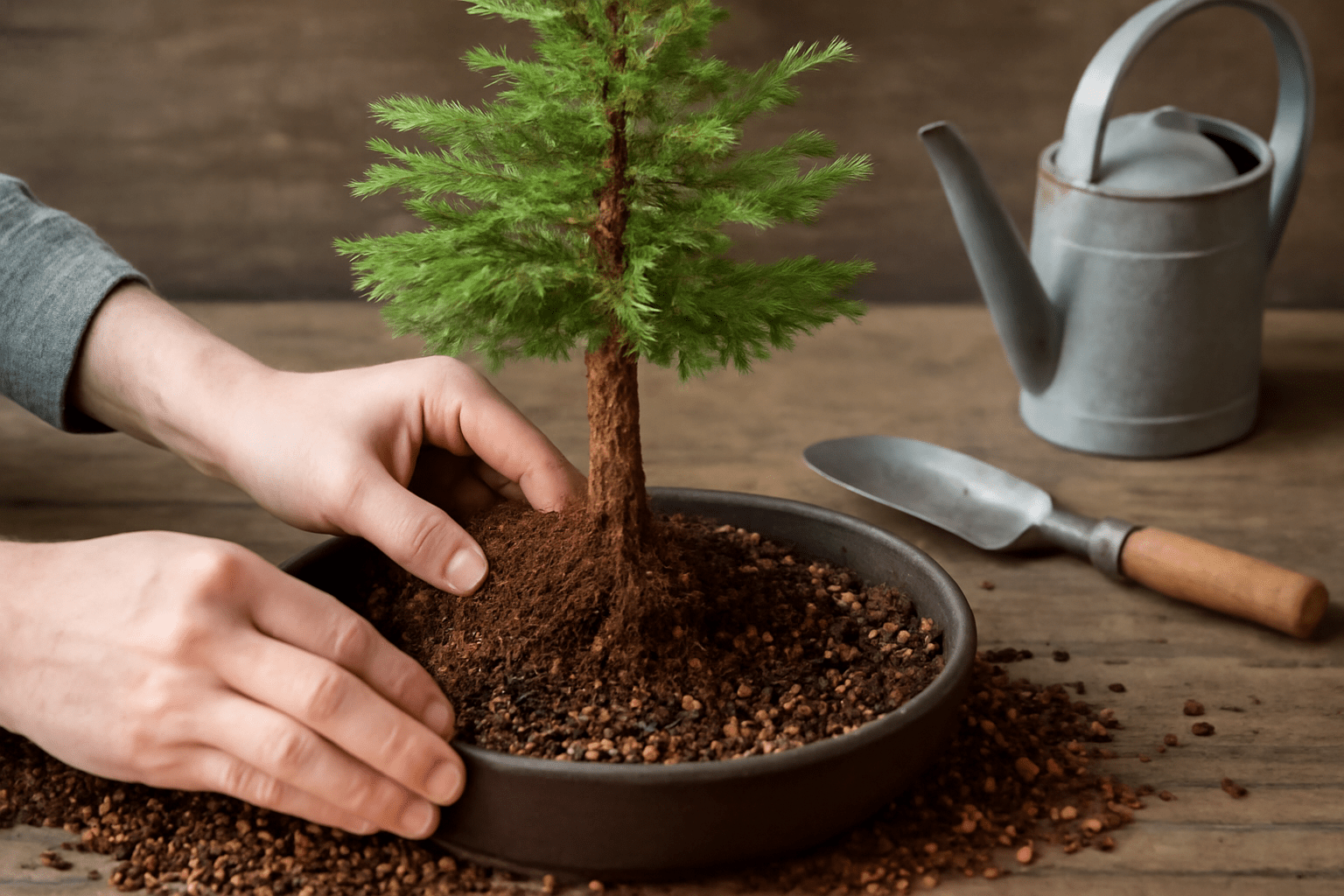
3. Prepare the Roots 
Before planting, gently remove the Sequoia from its nursery pot. Inspect the roots and trim any that are damaged or too long. Don’t overdo it – a little trimming helps the tree establish a strong, balanced root system. Be careful not to damage the main root mass, as this can affect the tree’s health.
4. Plant Your Sequoia 
Place your Bonsai Sequoia in the pot, making sure it’s centered. Gradually fill the pot with soil, gently tapping it down as you go to eliminate air pockets. Ensure that the tree is planted at the right depth—its base should be just below the rim of the pot, allowing space for water to sit.
5. Watering After Planting 
After planting, give your Bonsai Sequoia a thorough watering. This helps settle the soil around the roots and ensures that they are hydrated. Make sure the water drains freely through the pot. It’s best to water thoroughly, then allow the soil to dry slightly before watering again.
6. Location, Location, Location! 
Sequoias thrive in bright, indirect light. Place your newly potted tree in a location where it gets plenty of natural light but not too much direct sun, which could scorch the delicate leaves. A sunny windowsill or a spot with filtered sunlight is perfect. If you’re growing your tree indoors, consider a grow light if natural light is limited.
7. Initial Care and Observation 
For the first few weeks after planting, keep an eye on your Bonsai Sequoia’s health. Ensure the soil remains slightly moist (not soggy), and be cautious of any pests or diseases. During this period, avoid pruning or styling the tree too much. Let it settle and establish itself in its new home.
With these simple steps, you’ll be on your way to growing a healthy, thriving Bonsai Sequoia 
Bonsai Sequoia Care Essentials 
Caring for a Bonsai Sequoia is a rewarding experience, but it requires attention and patience. Whether you’re a seasoned bonsai grower or a beginner, following the right care routine will help your little sequoia thrive. Here’s your ultimate guide to Bonsai Sequoia care, simplified and packed with all the essentials you need!
1. Choosing the Right Location 
Bonsai Sequoias love the outdoors and need plenty of natural light to grow strong. Place your tree in a bright spot, ideally where it can receive 4-6 hours of direct sunlight each day. If you’re growing indoors, make sure it gets close to a south-facing window, or supplement with a grow light. Keep in mind, they prefer cool temperatures – nothing above 80°F (27°C) for long periods.

2. Watering 
Watering is crucial for the health of your Bonsai Sequoia. These trees like to stay moist but not soggy. Water the tree when the top of the soil feels slightly dry, but don’t let it dry out completely. Use a watering can with a fine spout to water gently and evenly. During the summer, your tree might need water every 1-2 days, while in the winter, you can reduce watering.
3. Soil and Potting 
Sequoia trees need well-draining soil to avoid root rot. A mix of akadama, pumice, and lava rock is ideal. Repot your Bonsai every 1-2 years to refresh the soil and ensure the roots have enough space to grow. When repotting, trim any overly long roots to encourage healthier growth. Make sure your pot has drainage holes to let excess water escape.
4. Pruning and Shaping 
Regular pruning helps maintain the compact size and shape of your Bonsai Sequoia. Trim back new growth in early spring and late summer to keep the tree’s shape and encourage branching. Use sharp, clean tools to make clean cuts and avoid damaging the tree. Be careful not to remove too much foliage at once. Shaping can also involve wiring branches to direct their growth—just be gentle, as Sequoia branches can break easily.
5. Fertilizing 
To support growth, fertilize your Bonsai Sequoia regularly. During the growing season (spring and summer), use a balanced liquid fertilizer every 4-6 weeks. In the fall and winter, reduce feeding to once a month or stop entirely. Over-fertilizing can lead to weak, spindly growth, so stick to a balanced routine.
6. Humidity and Temperature 
While Sequoia trees are hardy, they do best in a humid environment. If you’re growing your Bonsai indoors, place it on a humidity tray filled with water and pebbles to maintain moisture around the roots. Keep the tree in a cool spot, ideally between 50-75°F (10-24°C), and avoid placing it near heaters or air conditioners, as they can dry out the air.
7. Common Problems to Watch Out For 
- Pests: Keep an eye out for common bonsai pests like aphids or spider mites. If you spot any, treat with an insecticidal soap or neem oil.
- Yellowing Leaves: This can be a sign of overwatering or poor drainage. Check your soil and ensure proper watering habits.
- Root Rot: Always ensure your pot has drainage, and avoid letting the tree sit in water.
8. Winter Care 
During winter, your Bonsai Sequoia may go into a dormancy phase. To help it through this period, reduce watering and keep the tree in a cool, frost-free location. If your tree is indoors, try to provide extra humidity to combat dry indoor air.
With these care essentials, you’re well on your way to growing a healthy and beautiful Bonsai Sequoia! 
Common Problems and Troubleshooting 
Growing a Bonsai Sequoia can be a rewarding experience, but like any plant, it comes with its challenges. Whether you’re a seasoned gardener or a beginner, it’s important to recognize potential problems early and know how to address them. Here’s a quick guide to help you troubleshoot common issues and get your Sequoia back on track!
1. Yellowing Leaves 
Cause: Yellowing leaves are a sign of stress, often due to improper watering, poor drainage, or nutrient deficiencies.
Solution:
- Watering: Make sure you’re not overwatering or underwatering. Bonsai Sequoias like consistent moisture but don’t want soggy roots. Ensure your pot has good drainage.
- Fertilizing: Use a balanced fertilizer during the growing season (spring and summer) to provide essential nutrients.
- Check Placement: Ensure your tree gets plenty of indirect sunlight. Too little or too much light can cause stress.

2. Browning Tips or Edges 
Cause: Browning at the tips or edges of leaves typically points to water stress, excessive heat, or too much fertilizer.
Solution:
- Watering: Ensure the soil is consistently moist, but never waterlogged. If you notice browning, reduce watering and check if the soil drains well.
- Temperature: Keep your Bonsai Sequoia in a spot with cool, indirect light. Avoid placing it near heaters or air conditioners.
- Fertilizer: Be cautious with fertilizers. Too much can burn the roots and cause leaf edges to brown. Stick to a light, diluted solution.
3. Drooping or Wilting Leaves 
Cause: Drooping leaves often indicate a problem with the roots—either overwatering, underwatering, or root rot.
Solution:
- Root Check: If your Sequoia is drooping, gently remove it from the pot to inspect the roots. Healthy roots should be white or light brown. Dark, mushy roots mean root rot, which is a sign of overwatering.
- Watering: Ensure you’re watering properly. Let the soil dry slightly between waterings, but never let it dry out completely.
- Repotting: If you find root rot, trim the affected roots and repot the plant in fresh, well-draining soil.
4. Pests and Diseases 
Cause: Like any plant, Bonsai Sequoias can fall prey to pests like aphids, spider mites, or scale insects, which can damage leaves and stems.
Solution:
- Inspection: Regularly check your tree for signs of pests, such as webbing, spots, or visible bugs. Use a magnifying glass if necessary.
- Natural Remedies: If pests are present, gently rinse the leaves with a mixture of water and mild soap. You can also use neem oil for a natural pesticide. Just ensure it’s safe for Bonsai trees.
- Preventive Care: Keep your tree in a clean, well-ventilated area, and avoid overcrowding with other plants.
5. Overgrown or Leggy Tree 
Cause: A Bonsai Sequoia that grows too tall and spindly (leggy) is a sign that it’s not receiving enough light or that it’s been neglected in terms of pruning.
Solution:
- Pruning: Regularly prune your Bonsai Sequoia to maintain its shape and encourage new growth. Trim back any leggy branches and remove dead or yellowing leaves.
- Light: Ensure your tree is getting enough indirect light. If it’s growing tall and spindly, it may be reaching for more sunlight.
6. Rootbound Plant 
Cause: If your Bonsai Sequoia has outgrown its pot, the roots can become crowded, which leads to stunted growth.
Solution:
- Repotting: Every couple of years, or when you notice the roots becoming rootbound (circling the bottom of the pot), it’s time to repot your tree into a slightly larger container.
- Root Pruning: When repotting, prune any excessively long or damaged roots. This will help the tree develop a healthy root system and thrive.
By staying on top of these common issues and taking quick action, you’ll keep your Bonsai Sequoia happy and healthy for years to come! 
Bonsai Sequoia Growth and Shaping Techniques 

Growing and shaping a Bonsai Sequoia is a rewarding, albeit meticulous, process. Whether you’re a beginner or seasoned bonsai enthusiast, following a few key techniques can help your Sequoia thrive and develop into a stunning miniature masterpiece. Let’s break down the essential steps you need to follow for optimal growth and shaping of your Bonsai Sequoia.
1. Start with the Right Environment 
Sequoias love sunlight, so place your Bonsai in a spot that gets plenty of light—preferably around 4-6 hours of indirect sunlight daily. If you’re growing indoors, a south or west-facing window works best. During the colder months, ensure the tree gets enough warmth. Bonsai Sequoias also appreciate a moderate humidity level, so consider using a humidity tray or misting the leaves occasionally.
2. Proper Watering 
Sequoias, like all bonsai, require consistent watering. Ensure the soil is kept moist but never soggy. Water the tree when the top inch of soil feels dry, but be careful not to overwater, as this can lead to root rot. A good rule of thumb is to water thoroughly until water drains from the bottom of the pot.
3. Pruning and Shaping for a Balanced Structure 
Pruning is essential for maintaining the shape and health of your Bonsai Sequoia. The goal is to encourage a thick trunk and a dense canopy. Here’s how to do it right:
- Initial Pruning: Start by removing any dead or unhealthy branches. Focus on cutting back the tips of branches that are growing too long.
- Regular Maintenance: Throughout the growing season (typically spring to early fall), pinch back the new growth to promote a bushier appearance. Use scissors to carefully trim the excess growth at the tips of branches.
- Shape the Canopy: Work towards creating a triangular shape for the canopy, a hallmark of Sequoia bonsai. Ensure the lower branches remain fuller and thicker than the upper ones.
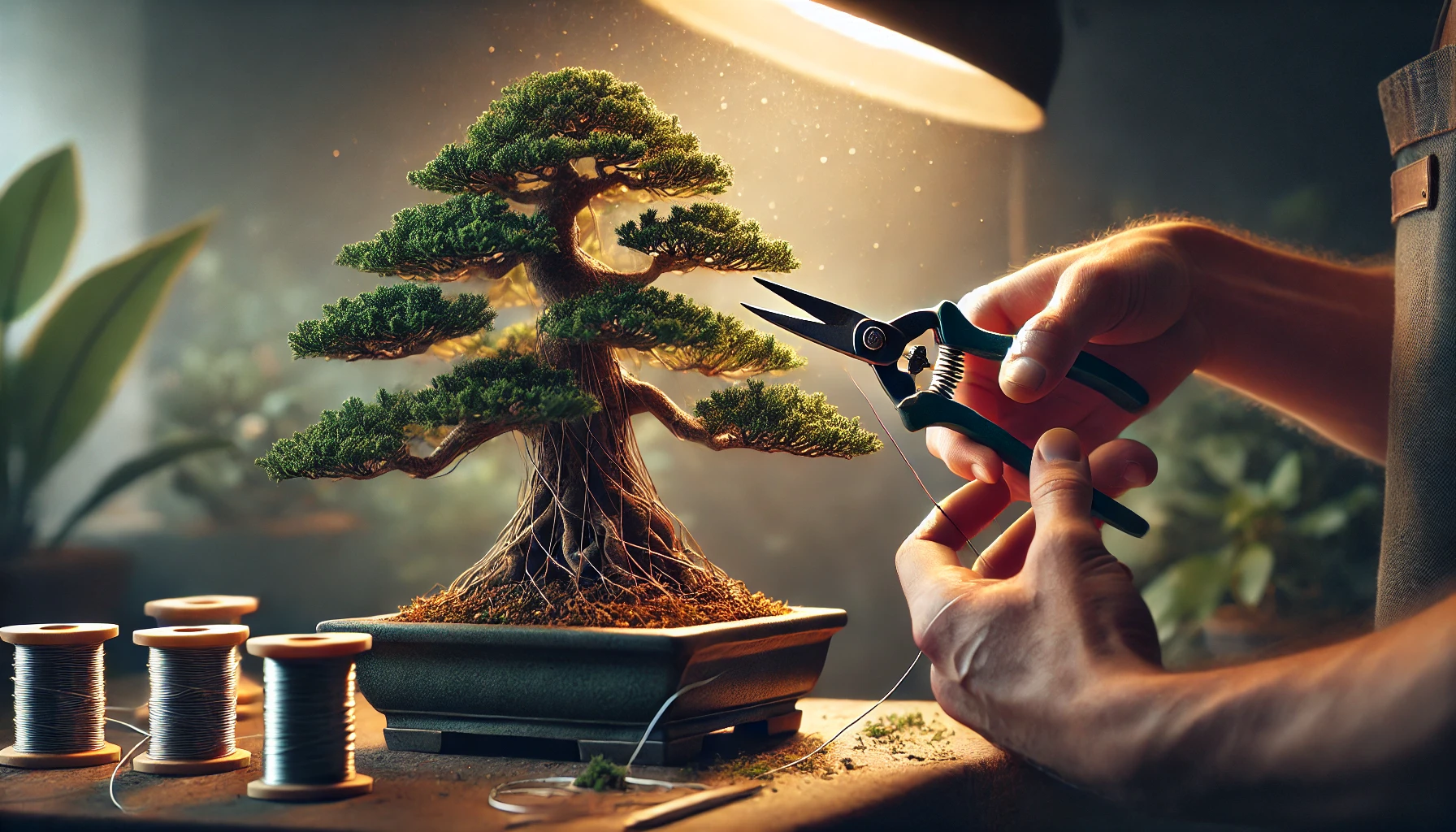
4. Wiring for Desired Shape 
Wiring is an excellent method to shape your Bonsai Sequoia and give it that characteristic “bonsai” appearance. Start by wrapping the branches with soft aluminum wire. Be gentle and avoid wrapping the wire too tightly to prevent damaging the bark.
- When to Wire: Wire your Bonsai during the growing season when the branches are still pliable but not too soft. Avoid wiring during winter when the tree is dormant.
- How to Wire: Begin by wiring the trunk to create a slight curve. Then, move on to shaping the branches by gently bending them into your desired position. Be sure to remove the wire after a few months to avoid it cutting into the tree’s bark.
5. Repotting and Root Pruning 
Repotting your Bonsai Sequoia is necessary to prevent root overcrowding and encourage healthy growth. Plan to repot every 2-3 years, or when you notice the roots becoming too dense.
- Timing: The best time to repot is in early spring before the tree starts its growth spurt.
- How to Repot: Carefully remove the tree from its pot and prune any long, circling roots. Trim around 1/3 of the root mass to promote new growth, and place the tree back in a pot that is slightly larger than the root ball.
- Soil: Use a well-draining bonsai soil mix that provides a balance of moisture retention and aeration.
6. Fertilizing for Healthy Growth 
Fertilizing is vital for the overall health of your Bonsai Sequoia. Use a balanced, water-soluble fertilizer to support strong growth. Apply fertilizer every 4-6 weeks during the growing season (spring to fall), and reduce fertilization in the winter when the tree is dormant.
7. Protecting from Pests and Diseases 
Like all plants, Bonsai Sequoias can attract pests such as aphids, spider mites, and scale insects. Regularly inspect your tree for signs of infestations, like sticky residue or discolored leaves.
- Natural Remedies: If pests appear, try using a mild insecticidal soap or neem oil to keep the pests under control. Regularly cleaning the leaves can also help prevent disease buildup.
- Ensure Proper Air Circulation: Proper airflow around the tree is essential in preventing fungal infections and other diseases.
Final Tips: Patience is Key! 
Shaping your Bonsai Sequoia requires patience and attention to detail. It might take several years to develop a full, balanced shape, but the effort is well worth it. Keep observing your tree, adjust techniques as necessary, and most importantly—enjoy the process! Bonsai care is as much about the journey as the destination.
With the right care and techniques, your Bonsai Sequoia will not only grow beautifully but also become a true work of art. Happy bonsai gardening!
Conclusion
Growing a bonsai Sequoia is a unique and rewarding experience that connects you with nature in a meaningful way. While it may take time and patience to nurture your miniature Sequoia, the results are worth the effort. By following the tips and techniques outlined in this guide—from setting up the right environment to pruning and shaping your tree—you’ll be able to care for your bonsai Sequoia like an expert.
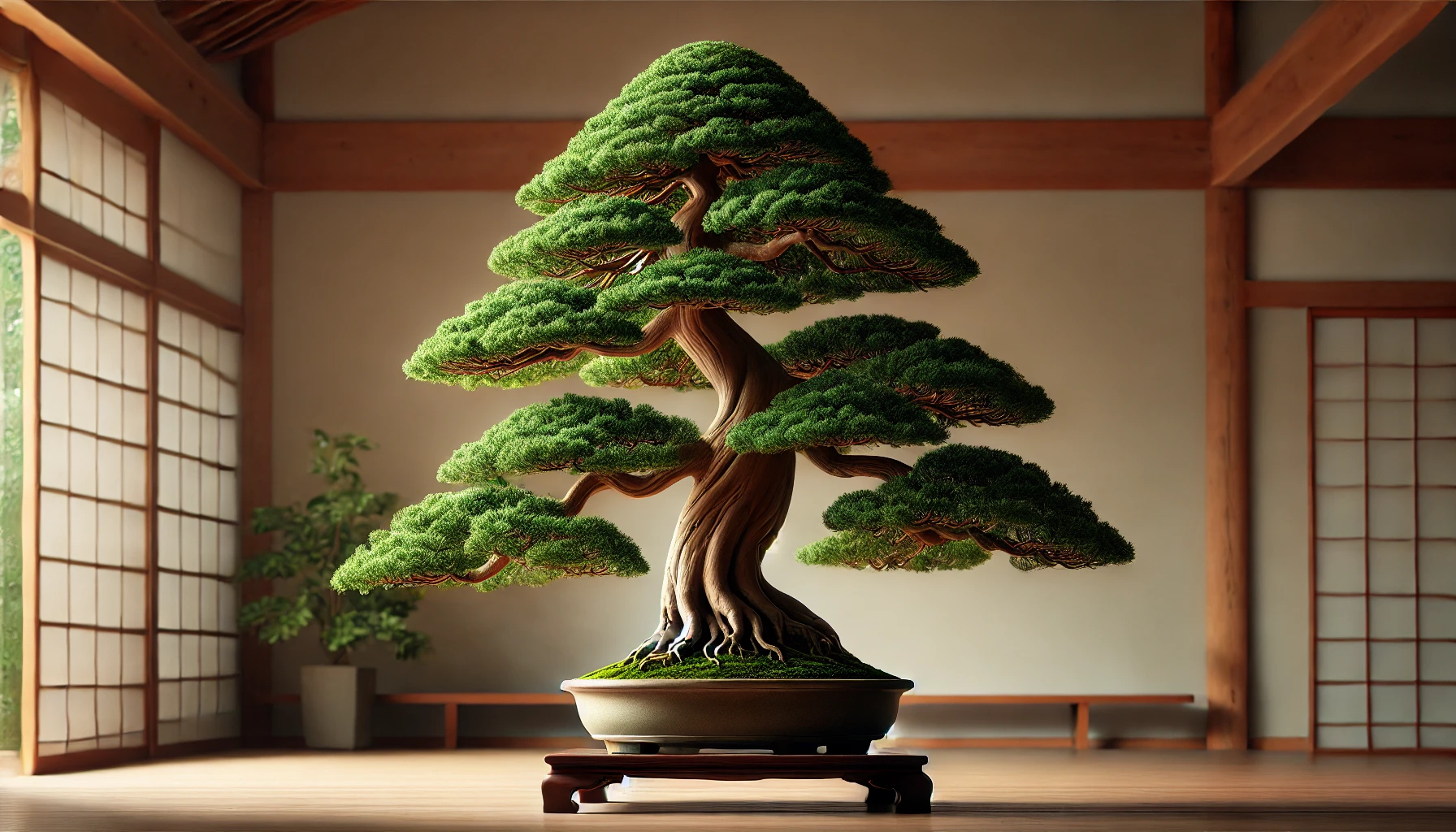
Remember, bonsai is not just about growing a tree; it’s about the process of cultivating patience, focus, and appreciation for nature’s beauty. Whether you’re a beginner or already have experience with bonsai, growing a Sequoia is a truly fulfilling journey.
Start your bonsai Sequoia adventure today, and enjoy the process of watching your tiny tree thrive and transform into a stunning, miniature replica of nature’s tallest giants.
Frequently Asked Questions(FAQ)
How long does it take for a bonsai Sequoia to grow?
A bonsai Sequoia grows slowly compared to other bonsai species. With proper care, it can take a few years to see significant growth. However, the tree’s small size remains manageable, making it a great choice for long-term cultivation.
Can I grow a bonsai Sequoia indoors?
Yes, bonsai Sequoias can be grown indoors, but they need plenty of sunlight—at least 6 hours a day. Make sure to place it near a south-facing window or under grow lights. However, they generally thrive better outdoors in temperate climates.
How often should I water my bonsai Sequoia?
Water your bonsai Sequoia when the top inch of soil feels dry. Depending on the environment, this may range from every few days to once a week. Ensure the pot has good drainage to avoid waterlogging, which can lead to root rot.
When should I prune my bonsai Sequoia?
Pruning should be done during the growing season, typically in spring and summer. Focus on removing dead or damaged branches, and trim new shoots to encourage a compact shape. Always prune carefully to maintain the natural structure of the tree.
What kind of soil is best for a bonsai Sequoia?
Bonsai Sequoias thrive in well-draining, slightly acidic soil. A good mix includes akadama (a clay-based soil), pumice, and lava rock to provide excellent drainage and aeration, which helps prevent root rot.
How do I prevent my bonsai Sequoia from becoming too leggy?
To prevent leggy growth, ensure your bonsai gets enough sunlight (at least 6 hours per day). Prune regularly to encourage lateral growth, and avoid over-fertilizing, as excessive nutrients can cause long, weak shoots.
Why are the leaves on my bonsai Sequoia turning yellow?
Yellowing leaves can indicate overwatering, poor drainage, or a nutrient deficiency. Check the soil moisture levels and ensure the plant is not sitting in soggy soil. Additionally, consider fertilizing your bonsai with a balanced,bonsai-specific fertilizer.
When should I repot my bonsai Sequoia?
Repot your bonsai Sequoia every 2 to 3 years or when the roots outgrow the pot. Early spring is the best time for repotting, just before the growing season begins. Use fresh, well-draining soil and prune the roots gently to fit the new pot.








